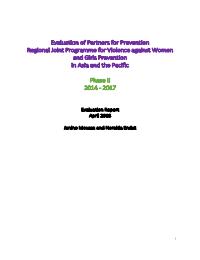
Partners for Prevention Phase II (P4P II)
Completedon 5 Apr, 2018
Evaluation Plan
Planned End Date
Mar 2018
Evaluation Type
Project
Management Response
Yes
Evaluation Budget
$20,000
Evaluation Title
Partners for Prevention Phase II (P4P II)
Plan Period
Status
Completed
Type
Project
Plan Date
27 Mar, 2018
Completion Date
5 Apr, 2018
Budget
$20,000
Expenditure
$20,000
Management Response
Yes
Quality Assessment
Yes
Joint Programme
Yes
Joint Evaluation
Yes
Joint With UN Agencies
GEF Evaluation
No
Countries
UNV
Plan Period
Status
Completed
Type
Project
Management Response
Yes
Plan Date
27 Mar, 2018
Quality Assessment
Yes
Completion Date
5 Apr, 2018
Joint Programme
Yes
Joint Evaluation
Yes
Joint With UN Agencies
Budget
$20,000
GEF Evaluation
No
Expenditure
$20,000
Countries
UNV


